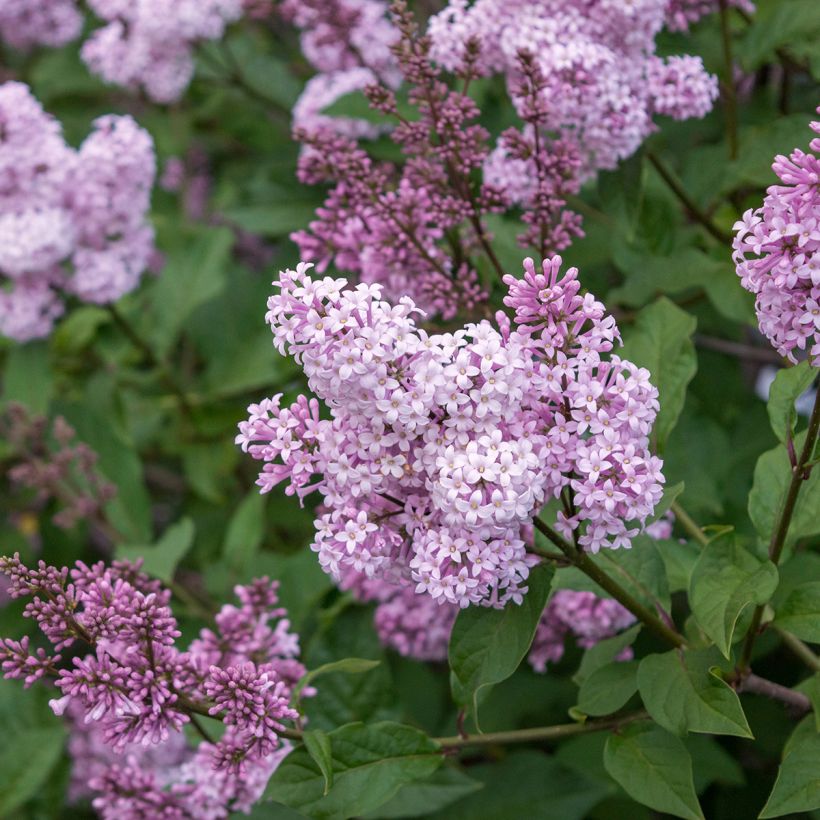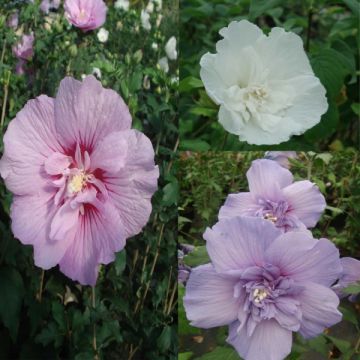

Syringa chinensis Saugeana - Lilac
Syringa chinensis Saugeana - Lilac
Syringa x chinensis Saugeana
Hybrid Lilac
Young plants half the height as advertised... recurring!!!
Vincent, 26/12/2021
Special offer!
Receive a €20 voucher for any order over €90 (excluding delivery costs, credit notes, and plastic-free options)!
1- Add your favorite plants to your cart.
2- Once you have reached €90, confirm your order (you can even choose the delivery date!).
3- As soon as your order is shipped, you will receive an email containing your voucher code, valid for 3 months (90 days).
Your voucher is unique and can only be used once, for any order with a minimum value of €20, excluding delivery costs.
Can be combined with other current offers, non-divisible and non-refundable.
Home or relay delivery (depending on size and destination)
Schedule delivery date,
and select date in basket
This plant carries a 24 months recovery warranty
More information
We guarantee the quality of our plants for a full growing cycle, and will replace at our expense any plant that fails to recover under normal climatic and planting conditions.
Would this plant suit my garden?
Set up your Plantfit profile →
Description
The Syringa x chinensis Saugeana, also known as Rouen Lilac or is a recent cultivar that combines qualities. With a flexible and naturally bushy habit, the bush offers a magnificent intensely fragrant flowering in spring, in long very beautifully coloured in pink violet panicles. Other flowers may appear more sporadically throughout the summer if the soil remains fresh. Very hardy and easy to grow even in calcareous soil. Drought-tolerant, the Saugeana lilac is an excellent plant for free hedges or standalone shrubs in all regions. This variety can also be grown in pots to perfume the terrace. A novelty to try out!
The Lilac x chinensis 'Saugeana' (synonyms Syringa dubia, S.rothomagensis, S. varina) is a horticultural achievement resulting from the hybridization of Syringa vulgaris, the common lilac, and S. protolaciniata, the Chinese lilac. All these plants belong to the Oleaceae family. The Syringa chinensis was discovered by M. Varin in 1777, which explains its common name of Varin Lilac. This bush is perfectly resistant to frost and shows a preference for clay-limestone soils.
Its silhouette is a bush both erect and rounded, compact and well ramified, almost as wide as it is high, supported by flexible and spread branches. Mature, it will reach about 3 m (9 ft 10 in) in height for a spread of 2.75 m. Its growth is quite slow, encouraged by a rich and fresh soil. This variety blooms abundantly from the end of April to the end of May depending on the region, always before the common lilacs. Its inflorescences are elongated pyramidal thyrses, a bit loose and pendulous, very fragrant, 15 to 25 cm (5.9 to 9.8 in) long, composed of small single flowers, of a rather bright pink-violet colour, pink-purple in buds. These inflorescences are grouped in bouquets at the end of last year's shoots, then again in summer or early autumn, when the current year's shoots may produce some inflorescences. This flowering attracts many butterflies and pollinating insects. Its dark green, deciduous foliage, composed of 6 to 8 cm (2.4 to 3.1 in) long leaves, takes on a beautiful yellow colour in autumn before falling.
Whether it is the perfume, childhood memories or even symbol of a significant event, everyone has a good reason to love lilacs, as endearing as they are devoid of pretension. The 'Saugeana' Lilac is no exception: hardy, easy to grow in ordinary soil even in cold or dry regions, vigorous and not demanding, it embodies the charm and wonderful simplicity of old gardens. This bush constitutes a major element for the creation of a fragrant garden, its flowering accompanying that of laburnums, roses and false jasmine. It can be planted on the edge of a grove, in a group, isolated or in a free hedge mixed with other trees (flowering apple trees, Japanese cherry trees, Chinese almond tree, Japanese quinces, Deutzias...). Its very fragrant clusters are perfect in spring bouquets, in the company of garden irises, peonies, bellflowers and florist's buttercups.
Syringa chinensis Saugeana - Lilac in pictures




Plant habit
Flowering
Foliage
Botanical data
Syringa
x chinensis
Saugeana
Oleaceae
Hybrid Lilac
Cultivar or hybrid
Planting and care
The Syringa 'Saugeana' is planted from November to March and from September to June. It accommodates any ordinary soil, but it prefers deep, loose, properly drained, clay-limestone soils. Once well established, this lilac tolerates summer drought fairly well (flowering will dry up in dry summer soil). A supply of a complete fertiliser every year at the start of the season is advisable. It is preferable to install it in full sun in cool regions, or in light shade in a hot climate, as its flowering is better when it receives maximum light, and when the winters are well contrasted. It is useful to cut off the faded inflorescences after flowering to avoid fruiting, which is of no interest, and which weakens the young plant. This will encourage a resurgence in summer and more abundant flowering the following year. This variety flowers on the shoots of the previous year, but also on the branches of the current year. Avoid severe prunings that limit the flowering of the following spring, unless your lilac becomes too large.
Planting period
Intended location
Care
Planting & care advice
-
, onOrder confirmed
Reply from on Promesse de fleurs
Similar products
Haven't found what you were looking for?
Hardiness is the lowest winter temperature a plant can endure without suffering serious damage or even dying. However, hardiness is affected by location (a sheltered area, such as a patio), protection (winter cover) and soil type (hardiness is improved by well-drained soil).

Photo Sharing Terms & Conditions
In order to encourage gardeners to interact and share their experiences, Promesse de fleurs offers various media enabling content to be uploaded onto its Site - in particular via the ‘Photo sharing’ module.
The User agrees to refrain from:
- Posting any content that is illegal, prejudicial, insulting, racist, inciteful to hatred, revisionist, contrary to public decency, that infringes on privacy or on the privacy rights of third parties, in particular the publicity rights of persons and goods, intellectual property rights, or the right to privacy.
- Submitting content on behalf of a third party;
- Impersonate the identity of a third party and/or publish any personal information about a third party;
In general, the User undertakes to refrain from any unethical behaviour.
All Content (in particular text, comments, files, images, photos, videos, creative works, etc.), which may be subject to property or intellectual property rights, image or other private rights, shall remain the property of the User, subject to the limited rights granted by the terms of the licence granted by Promesse de fleurs as stated below. Users are at liberty to publish or not to publish such Content on the Site, notably via the ‘Photo Sharing’ facility, and accept that this Content shall be made public and freely accessible, notably on the Internet.
Users further acknowledge, undertake to have ,and guarantee that they hold all necessary rights and permissions to publish such material on the Site, in particular with regard to the legislation in force pertaining to any privacy, property, intellectual property, image, or contractual rights, or rights of any other nature. By publishing such Content on the Site, Users acknowledge accepting full liability as publishers of the Content within the meaning of the law, and grant Promesse de fleurs, free of charge, an inclusive, worldwide licence for the said Content for the entire duration of its publication, including all reproduction, representation, up/downloading, displaying, performing, transmission, and storage rights.
Users also grant permission for their name to be linked to the Content and accept that this link may not always be made available.
By engaging in posting material, Users consent to their Content becoming automatically accessible on the Internet, in particular on other sites and/or blogs and/or web pages of the Promesse de fleurs site, including in particular social pages and the Promesse de fleurs catalogue.
Users may secure the removal of entrusted content free of charge by issuing a simple request via our contact form.
The flowering period indicated on our website applies to countries and regions located in USDA zone 8 (France, the United Kingdom, Ireland, the Netherlands, etc.)
It will vary according to where you live:
- In zones 9 to 10 (Italy, Spain, Greece, etc.), flowering will occur about 2 to 4 weeks earlier.
- In zones 6 to 7 (Germany, Poland, Slovenia, and lower mountainous regions), flowering will be delayed by 2 to 3 weeks.
- In zone 5 (Central Europe, Scandinavia), blooming will be delayed by 3 to 5 weeks.
In temperate climates, pruning of spring-flowering shrubs (forsythia, spireas, etc.) should be done just after flowering.
Pruning of summer-flowering shrubs (Indian Lilac, Perovskia, etc.) can be done in winter or spring.
In cold regions as well as with frost-sensitive plants, avoid pruning too early when severe frosts may still occur.
The planting period indicated on our website applies to countries and regions located in USDA zone 8 (France, United Kingdom, Ireland, Netherlands).
It will vary according to where you live:
- In Mediterranean zones (Marseille, Madrid, Milan, etc.), autumn and winter are the best planting periods.
- In continental zones (Strasbourg, Munich, Vienna, etc.), delay planting by 2 to 3 weeks in spring and bring it forward by 2 to 4 weeks in autumn.
- In mountainous regions (the Alps, Pyrenees, Carpathians, etc.), it is best to plant in late spring (May-June) or late summer (August-September).
The harvesting period indicated on our website applies to countries and regions in USDA zone 8 (France, England, Ireland, the Netherlands).
In colder areas (Scandinavia, Poland, Austria...) fruit and vegetable harvests are likely to be delayed by 3-4 weeks.
In warmer areas (Italy, Spain, Greece, etc.), harvesting will probably take place earlier, depending on weather conditions.
The sowing periods indicated on our website apply to countries and regions within USDA Zone 8 (France, UK, Ireland, Netherlands).
In colder areas (Scandinavia, Poland, Austria...), delay any outdoor sowing by 3-4 weeks, or sow under glass.
In warmer climes (Italy, Spain, Greece, etc.), bring outdoor sowing forward by a few weeks.

















































